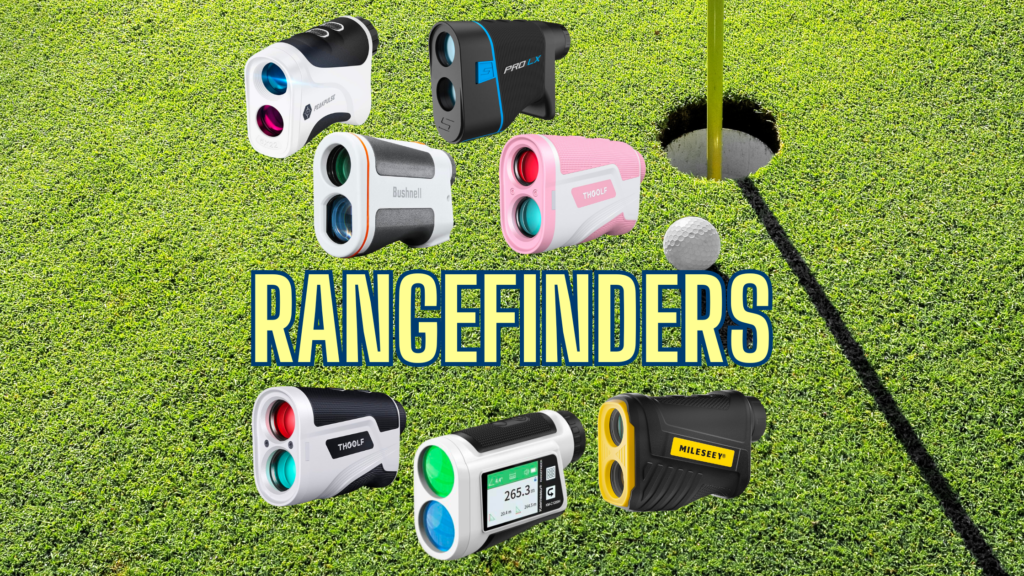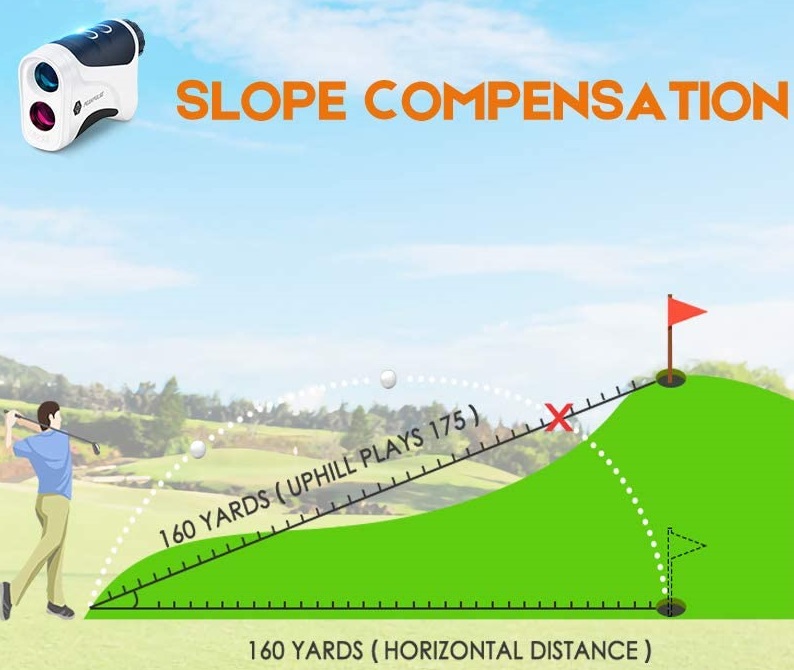Golf Rangefinders Explained: What Are They and How Do They Work?

Golfers make a lot of decisions when playing a round of golf. They have to decide which club to use before every shot, and then golfers have to figure out how hard they need to hit the ball.
If golfers don’t know how far away the target is, these decisions are based on little more than guesswork. That is why most serious golfers now consider golf rangefinders to be crucial pieces of equipment, similar to cleats for players in NFL games.
These compact devices provide distance and slope information in just a second or two, and using one could save golfers many strokes and lower their scores. A Golf Rangefinder can contain laser, GPS or optical technology, and all three approaches have their pros and cons.
Laser Golf Rangefinders
A laser golf rangefinder works by sending a beam of light to a reflective target and then measuring how long it takes the reflected light to return to the device. Laser rangefinders have become extremely popular in recent years because they are inexpensive. They are also easy to use, very accurate, and small enough to fit inside any golf bag. Read more about which laser rangefinder I use.
You will need a reflective surface to bounce the laser beam off if you want high accuracy. That should not be a problem as most golf courses now have reflective strips on pins, at the fronts and backs of greens and near hazards.
To use laser rangefinders, golfers look through the eyepiece on the back of the device and press a button. Watch the video below to see how to use a golf rangefinder correctly.
Laser Golf Rangefinder Features
If you decide to buy a laser rangefinder, you will have a dizzying array of options to choose from. All of these devices work in basically the same way, but models at the upper end of the price spectrum have more advanced features.
Here are some of the features that could help you to get more out of a laser rangefinder:
- Enhanced magnification: Finding reflective material close to your target will be much easier if your laser rangefinder has a powerful magnification feature. Models that magnify an image six times are available for less than $100.
- Slope measurement: Laser rangefinders with slope measurement features calculate incline and decline angles and provide a basic distance reading and a reading adjusted for gradient. This feature must be switched on manually because it is not permitted in tournament play. Want to know more about slope features on a rangefinder? Checkout our comprehensive guide to Slope Compensation Modes.

- Pin locking: This laser rangefinder feature acquires the pin automatically from up to 300 yards away.
- Pulse confirmation: If the laser rangefinder you choose has a pulse confirmation feature, it will vibrate gently in your hand to let you know that it has locked onto your target.
- Rain and fog mode: Laser rangefinders used to be much less reliable in rain or dense fog. The latest models have technology that accounts for inclement weather to improve accuracy.
GPS Golf Rangefinders
If you want to accurately measure your golf shots but don’t want to carry around an extra piece of equipment, you can use GPS technology to obtain distance and slope information. There are GPS rangefinder apps that can be downloaded for Android or iOS devices, and there are also GPS rangefinders that can be worn on the wrist like a watch.
These rangefinders use GPS satellites to identify your location and the location of your target. They only work if they have information about the course you are playing. This is rarely something that you will have to worry about because most GPS apps and devices come preloaded with tens of thousands of golf course layouts.
If your course is not preloaded, you will probably be able to download the layout from the club website. GPS rangefinders are not quite as accurate as laser rangefinders, but they work in all weather conditions and are very easy to use.
GPS Golf Rangefinder Features
Many golfers swear by GPS rangefinders because they use the latest technology to deliver features that are not available on traditional devices. These features include:
- Bluetooth connectivity: When the layout of your course changes, Bluetooth connectivity allows you to download the new information quickly.
- One-touch activation: Connecting to GPS satellites is much easier when all you have to do is press a button.
- Hole progression: GPS technology tracks your position as you play your round. This means devices that use it can provide you with updated gradient and distance information automatically.
- Club suggestions: If you sometimes find it hard to decide which club to use for your next shot, a GPS rangefinder with a club selection feature could come in very handy.
- Hazard indicators: Hidden bunkers and traps can cost you strokes. GPS devices with hazard indicators let you know where they are so you can plan your shots accordingly.
Optical Golf Rangefinders
Before the introduction of laser and GPS rangefinders, golfers used optical devices based on coincidence rangefinders to measure distances. These devices are affordable because they do not contain any sophisticated technology, but they can be tricky to use.
If you know how to focus a telescope or pair of binoculars, you will be judging distances in no time. An adjustment button or dial on an optical rangefinder moves two lenses inside the device that reflect light onto mirrors.
When the image in the viewfinder becomes clear, the distance is displayed. The more basic, optical rangefinders are not the most accurate devices on the market, but many old-school golfers prefer them.
Optical Golf Rangefinder Features
Optical rangefinders are fairly basic devices, but they work in any conditions and don’t need batteries. Here are some features that you should look out for if you decide to buy an optical rangefinder:
- Powerful magnification: Just like binoculars, optical rangefinders are available with varying levels of magnification. If you want to use one of these devices to measure gold shots, look for at least six times magnification.
- Adjustment dials: Fine-tuning an optical rangefinder is much easier with a dial. If golfers easily frustrated, they should avoid devices with buttons.
- Quality lenses: Lenses with anti-ultraviolet light coatings and scratch protection can be found in even inexpensive optical rangefinders.
Summary
A round of golf should be both challenging and enjoyable. Any equipment that takes some of the stress out of playing 18 holes should be welcomed. A golf rangefinder can provide you with accurate distance and slope information in mere seconds, which can make choosing the right club and selecting the right shot much easier.
Optical rangefinders have been used in golf for years, but they are not as accurate as devices that measure distances and gradients with laser beams. Rangefinders that use GPS offer a host of useful features and work better in the cold, rain and heavy fog.
Looking to research the best golf rangefinder? Why not checkout all our rangefinder related articles, in particular, it’s worth looking at the CIGMAN CT-1000 if you’re looking for a good rangefinder at a budget price.
Bye for now!

Last Updated on 02/12/2024 by StripeyGreenTV
